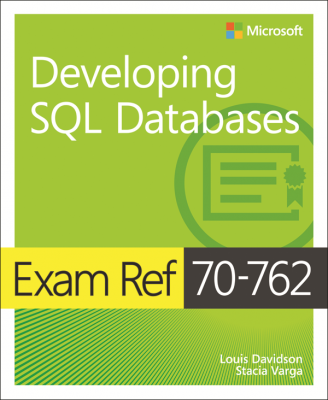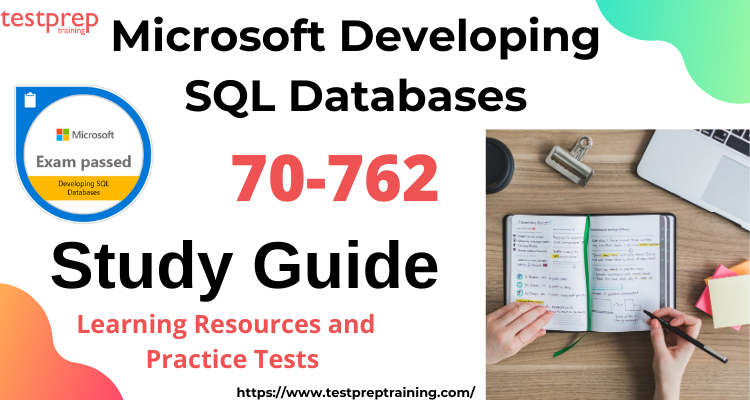Want to become an MCSA: SQL 2016 Database Development? Do you want to pass the Microsoft Developing SQL Databases 70-762 exam? Then you have hit the right place. This study guide is going to be your information goldmine. It is going to equip you with the right resources to pass the exam. Further, it provides detailed steps to set you on the right track. Let’s sail through the exam details before diving deep into the preparations journey.
Developing SQL Databases 70-762 exam is made for database experts who construct and put databases into action across organizations, making sure that data is highly available. This test checks how well you can do technical things like creating and using database elements, putting programmability objects into action, handling database overlap, and improving database elements and the SQL setup. While the exam might focus on these areas, it’s not only about them. To do well, you need to have a strong understanding of the concepts behind them.
Who should take Microsoft 70-762 exam?
The 70-762 SQL Database Development Exam targets database experts engaged in constructing and deploying databases across various organizations, ensuring robust data availability. Candidate duties encompass crafting database files, data types, and tables; strategizing, crafting, and enhancing indexes; guaranteeing data integrity; executing views, stored procedures, and functions; and overseeing transactions and locks.
Study guide for Exam 70-762: Microsoft Developing SQL Databases
Your success will depend on how well did you prepare for the exam. To ace the exam, you have to prepare from all relevant resource available to you. Here is the list of some of the resources which may show you the way. But always remember that there is no end to knowledge, you have endless resources beyond this list. Let us look at the steps to be on the right track.

Step 1- Refer the Microsoft 70-762 Official Guide
Before embarking on any journey, it’s crucial to understand what you’re getting into. In this case, thoroughly going through each exam objective is the key part of your preparation. Visit the official exam website for the most accurate information—it’s the most reliable source. Once you’ve covered the fundamental exam details. It’s time to hit the Official Exam Guide. Remember to review each and every domain of this exam. Tailor your study plan around the exam objectives. Following are the exam domains:
Domain 1- Design and implement database objects (25–30%)
This module will test you on the following basis design and implement a relational database scheme. Design tables and schemas based on business requirements, improve the design of tables by using normalization, write table create statements, determine the most efficient data types to use. Also, Design new indexes based on provided tables, queries, or plans; distinguish between indexed columns and included columns. Implement clustered index columns by using best practices; recommend new indexes based on query plans. Then, Design and implement views- Design a view structure to select data based on user or business requirements, identify the steps necessary to design an updateable view, implement partitioned views, implement indexed views. Further, implement columnstore indexes. Determine use cases that support the use of columnstore indexes, identify proper usage of clustered and non-clustered columnstore indexes, design standard non-clustered indexes in conjunction with clustered columnstore indexes, implement columnstore index maintenance.
Domain 2- Implement programmability objects (20–25%)
This module will judge you on the concepts to ensure data integrity with constraints. Define table and foreign key constraints to enforce business rules, write Transact-SQL statements to add constraints to tables, identify results of Data Manipulation Language (DML) statements given existing tables and constraints, identify proper usage of PRIMARY KEY constraints. Also, create stored procedures. Design stored procedure components and structure based on business requirements, implement input and output parameters, implement table-valued parameters, implement return codes, streamline existing stored procedure logic, implement error handling and transaction control logic within stored procedures. Moreover, create triggers and user-defined functions- Design trigger logic based on business requirements; determine when to use Data Manipulation Language (DML) triggers, Data Definition Language (DDL) triggers, or logon triggers; recognize results based on execution of AFTER or INSTEAD OF triggers; design scalar-valued and table-valued user-defined functions based on business requirements; identify differences between deterministic and non-deterministic functions.
Domain 3- Manage database concurrency (25–30%)
This module will try-on you on the concepts to implement transactions. Identify DML statement results based on transaction behavior, recognize differences between and identify usage of explicit and implicit transactions, implement save points within transactions, determine the role of transactions in high-concurrency databases. Further, manage isolation levels- Identify differences between Read Uncommitted, Read Committed, Repeatable Read, Serializable, and Snapshot isolation levels; define results of concurrent queries based on isolation level; identify the resource and performance impact of given isolation levels. Also, optimize concurrency and locking behavior- Troubleshoot locking issues, identify lock escalation behaviors, capture and analyze deadlock graphs, identify ways to remediate deadlocks. Additionally, implement memory-optimized tables and native stored procedures. Define use cases for memory-optimized tables versus traditional disk-based tables, optimize performance of in-memory tables by changing durability settings, determine best case usage scenarios for natively compiled stored procedures, enable collection of execution statistics for natively compiled stored procedures.
Domain 4- Optimize database objects and SQL infrastructure (20–25%)
This module will evaluate you on optimize statistics and indexes. Then, determine the accuracy of statistics and the associated impact to query plans and performance, design statistics maintenance tasks, use dynamic management objects to review current index usage and identify missing indexes, consolidate overlapping indexes. Also, analyze and troubleshoot query plans. Further, Manage performance for database instances. Optimize database file and tempdb configuration; optimize memory configuration; monitor and diagnose scheduling and wait statistics using dynamic management objects. Troubleshoot and analyze storage, IO, and cache issues; monitor Azure SQL Database query plans. Identify differences between performance monitoring and logging tools, such as perfmon and dynamic management objects. Also, compare the impact of Extended Events and SQL Trace; define differences between Extended Events Packages, Targets, Actions, and Sessions.
Step 2- Gather Relevant Resources
Achieving success in the exam becomes simpler when you have the correct resources at your disposal. Ensure that the content is both accurate and dependable. Your choice of resources plays a crucial role in how effectively you prepare and ultimately pass the exam. Therefore, exercise caution when selecting your preparatory resources. Let’s explore some of the highly recommended resources.

Learn with Libraries and the books
Books are another valuable resource for preparation. You can find many books available online or you can take any book from libraries or bookstores as per your ease. Further, you can choose various books and prepare the topic that is best in the book. Also, prepare from the book prescribed by Microsoft- Exam Ref 70-762 Developing SQL Databases. This book covers all the concepts that are required for clearing the exam.
Enrol for Online classes and Instructor-led training
You can find lots of resources on the internet, like classes and training from online education websites. These classes are interactive and can help you understand things better. Plus, they keep you in the loop about any changes in the syllabus or other important updates.
Join online study groups
When more people join in to solve a problem, the chances of finding a solution go way up. Having different opinions makes things more interesting and brings more life to the subject. These talks help cover a lot of ground in our studies. Even introverts get a chance to share their thoughts, especially those who usually avoid speaking up. Forums are great for building a community, and that’s important for understanding others. So, don’t forget to be part of study groups as you prepare.
Step 3- Attempt Practice papers
Practice papers are a big help when it comes to exams. They give your brain a workout and get it ready for the real deal. Besides just knowing the factors, other things can impact how well you do in exams. Factors like confidence, speed, knowing how they grade, and being physically and mentally sharp all play a role. Lets start practising for Microsoft 70-762 exam Now!



